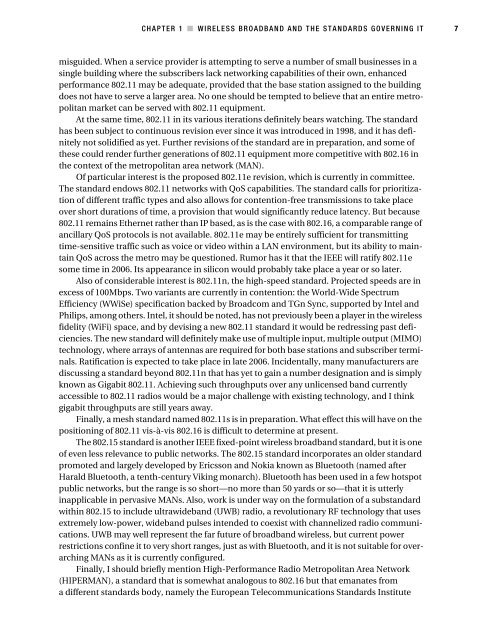WiMax Operator's Manual
WiMax Operator's Manual
WiMax Operator's Manual
You also want an ePaper? Increase the reach of your titles
YUMPU automatically turns print PDFs into web optimized ePapers that Google loves.
CHAPTER 1 ■ WIRELESS BROADBAND AND THE STANDARDS GOVERNING IT 7<br />
misguided. When a service provider is attempting to serve a number of small businesses in a<br />
single building where the subscribers lack networking capabilities of their own, enhanced<br />
performance 802.11 may be adequate, provided that the base station assigned to the building<br />
does not have to serve a larger area. No one should be tempted to believe that an entire metropolitan<br />
market can be served with 802.11 equipment.<br />
At the same time, 802.11 in its various iterations definitely bears watching. The standard<br />
has been subject to continuous revision ever since it was introduced in 1998, and it has definitely<br />
not solidified as yet. Further revisions of the standard are in preparation, and some of<br />
these could render further generations of 802.11 equipment more competitive with 802.16 in<br />
the context of the metropolitan area network (MAN).<br />
Of particular interest is the proposed 802.11e revision, which is currently in committee.<br />
The standard endows 802.11 networks with QoS capabilities. The standard calls for prioritization<br />
of different traffic types and also allows for contention-free transmissions to take place<br />
over short durations of time, a provision that would significantly reduce latency. But because<br />
802.11 remains Ethernet rather than IP based, as is the case with 802.16, a comparable range of<br />
ancillary QoS protocols is not available. 802.11e may be entirely sufficient for transmitting<br />
time-sensitive traffic such as voice or video within a LAN environment, but its ability to maintain<br />
QoS across the metro may be questioned. Rumor has it that the IEEE will ratify 802.11e<br />
some time in 2006. Its appearance in silicon would probably take place a year or so later.<br />
Also of considerable interest is 802.11n, the high-speed standard. Projected speeds are in<br />
excess of 100Mbps. Two variants are currently in contention: the World-Wide Spectrum<br />
Efficiency (WWiSe) specification backed by Broadcom and TGn Sync, supported by Intel and<br />
Philips, among others. Intel, it should be noted, has not previously been a player in the wireless<br />
fidelity (WiFi) space, and by devising a new 802.11 standard it would be redressing past deficiencies.<br />
The new standard will definitely make use of multiple input, multiple output (MIMO)<br />
technology, where arrays of antennas are required for both base stations and subscriber terminals.<br />
Ratification is expected to take place in late 2006. Incidentally, many manufacturers are<br />
discussing a standard beyond 802.11n that has yet to gain a number designation and is simply<br />
known as Gigabit 802.11. Achieving such throughputs over any unlicensed band currently<br />
accessible to 802.11 radios would be a major challenge with existing technology, and I think<br />
gigabit throughputs are still years away.<br />
Finally, a mesh standard named 802.11s is in preparation. What effect this will have on the<br />
positioning of 802.11 vis-à-vis 802.16 is difficult to determine at present.<br />
The 802.15 standard is another IEEE fixed-point wireless broadband standard, but it is one<br />
of even less relevance to public networks. The 802.15 standard incorporates an older standard<br />
promoted and largely developed by Ericsson and Nokia known as Bluetooth (named after<br />
Harald Bluetooth, a tenth-century Viking monarch). Bluetooth has been used in a few hotspot<br />
public networks, but the range is so short—no more than 50 yards or so—that it is utterly<br />
inapplicable in pervasive MANs. Also, work is under way on the formulation of a substandard<br />
within 802.15 to include ultrawideband (UWB) radio, a revolutionary RF technology that uses<br />
extremely low-power, wideband pulses intended to coexist with channelized radio communications.<br />
UWB may well represent the far future of broadband wireless, but current power<br />
restrictions confine it to very short ranges, just as with Bluetooth, and it is not suitable for overarching<br />
MANs as it is currently configured.<br />
Finally, I should briefly mention High-Performance Radio Metropolitan Area Network<br />
(HIPERMAN), a standard that is somewhat analogous to 802.16 but that emanates from<br />
a different standards body, namely the European Telecommunications Standards Institute
















